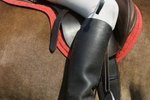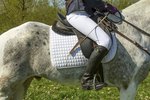The size of your saddle's tree will determine the way the saddle fits your horse. The equine industry does not have a required guideline that designates tree size, but you can use several methods to closely approximate the size of your saddle's tree.
Contact the Manufacturer
The easiest way to determine saddle tree size is by contacting the manufacturer and asking. A decent quality saddle will have both a manufacturer's label and a serial number stamped or engraved on a plate that is located somewhere on the saddle. This information is normally located on the left strap holder or on the fender. You also may find it on the stirrup strap.
Once you have found the saddle's manufacturer and the model or serial number for your saddle, email or call the manufacturer's customer service department. Ask them to look up the information on your saddle's tree size. If the manufacturer is no longer in business, a little bit of Internet researching will often give you the information you need.
Measuring the Saddle Tree
Saddle tree size is determined by the angle of the bars of the saddle as they come down from the gullet. The greater the angle of the bars is, the wider the tree. You can make specific measurements by using a device that is specifically designed to measure angles, also known as a protractor.
Generally speaking, a saddle with a normal or narrow bar angle is classified as having regular or semi-quarter horse bars. The exact measurement of these bars will be an angle of 86 degrees, plus or minus 3 degrees in either direction. A saddle that has full quarter horse bars, also known as a wide tree, generally has a measurement of 90 degrees, plus or minus 3. A very wide tree will have an angle of 94 degrees plus or minus 3. Very wide trees are often used on large horses such as drafts.
Tips
A number of saddle tree measurement templates are available online and will make the task of determining saddle tree size much easier. Download and print these templates and line them up with your saddle until you find the one that matches your saddle.
Warnings
The size of your saddle tree is important because a saddle that is too wide or too narrow for your horse's back will interfere with your horse's ability to move comfortably. A poorly fitting saddle can cause your horse a significant amount of discomfort and even result in a lasting injury that requires veterinary care. If you are unsure as to whether your saddle has the right size tree for your horse, enlist the help of a professional saddle fitter to check your saddle fit.
References
Writer Bio
Jen Davis has been writing since 2004. She has served as a newspaper reporter and her freelance articles have appeared in magazines such as "Horses Incorporated," "The Paisley Pony" and "Alabama Living." Davis earned her Bachelor of Arts in communication with a concentration in journalism from Berry College in Rome, Ga.



